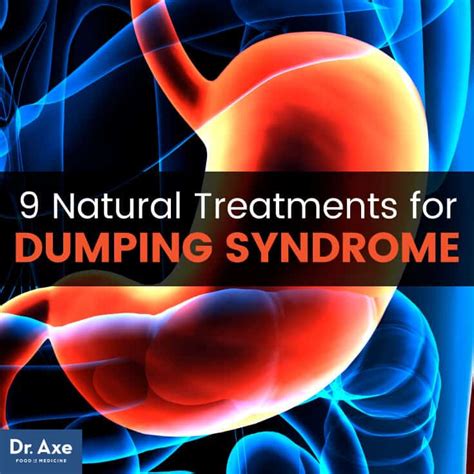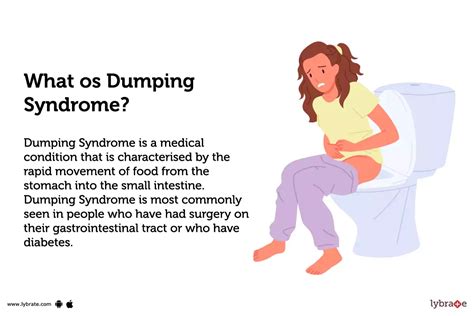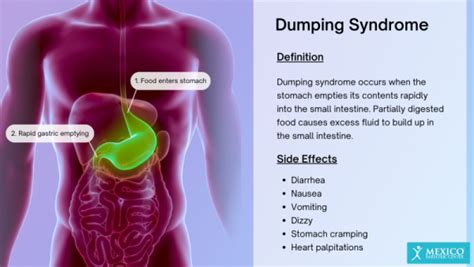Intro
Learn about Dumping Syndrome Treatment, managing rapid gastric emptying symptoms with dietary changes, medication, and surgery, alleviating nausea, diarrhea, and abdominal pain.
Dumping syndrome is a condition that occurs when food, especially sugar, moves from the stomach to the small bowel too quickly. This can happen after surgery to remove all or part of the stomach, such as gastrectomy. Dumping syndrome can cause a range of symptoms, including nausea, vomiting, diarrhea, and abdominal cramps. In severe cases, it can lead to malnutrition, dehydration, and even death. Therefore, it is essential to understand the importance of treating dumping syndrome to manage its symptoms and prevent complications.
The treatment of dumping syndrome is crucial to improve the quality of life of individuals who have undergone stomach surgery. Without proper treatment, dumping syndrome can lead to malnutrition, dehydration, and other complications. Treatment options for dumping syndrome typically involve dietary changes, medication, and, in some cases, further surgery. Dietary changes are often the first line of treatment and involve eating smaller, more frequent meals, avoiding sugary foods and drinks, and increasing the consumption of protein and fiber-rich foods. Medications, such as octreotide, can also be used to slow down the movement of food from the stomach to the small bowel and reduce symptoms.
Dumping syndrome can significantly impact an individual's daily life, making it challenging to manage symptoms and maintain a healthy diet. Understanding the treatment options available is vital to managing the condition effectively. By making dietary changes, taking medication, and, in some cases, undergoing further surgery, individuals with dumping syndrome can reduce their symptoms and improve their overall health. In this article, we will delve into the treatment options for dumping syndrome, exploring the benefits, working mechanisms, and steps involved in managing the condition.
Dietary Changes for Dumping Syndrome Treatment

Some specific dietary changes that may help manage dumping syndrome include:
- Eating six small meals per day instead of three large meals
- Avoiding sugary foods and drinks, such as candy, cakes, and sweetened beverages
- Increasing the consumption of protein-rich foods, such as lean meats, fish, and eggs
- Increasing the consumption of fiber-rich foods, such as fruits, vegetables, and whole grains
- Avoiding fatty foods, which can slow down digestion and worsen symptoms
- Drinking water and other low-calorie fluids between meals to stay hydrated
Medications for Dumping Syndrome Treatment

Other medications that may be used to treat dumping syndrome include:
- Anti-diarrheal medications, such as loperamide, to reduce diarrhea
- Anti-nausea medications, such as ondansetron, to reduce nausea and vomiting
- Acid-reducing medications, such as ranitidine, to reduce stomach acid and alleviate symptoms
How Medications Work
Medications for dumping syndrome work by slowing down the movement of food from the stomach to the small bowel, reducing the severity of symptoms. Octreotide, for example, works by reducing the secretion of hormones that stimulate the movement of food from the stomach to the small bowel. This can help reduce symptoms such as diarrhea, nausea, and vomiting.Surgical Treatment for Dumping Syndrome

Surgical treatment is usually reserved for individuals who have severe dumping syndrome that does not respond to dietary changes or medication. The goal of surgical treatment is to slow down the movement of food from the stomach to the small bowel, reducing symptoms.
Risks and Benefits of Surgical Treatment
Surgical treatment for dumping syndrome carries risks and benefits. The benefits of surgical treatment include: * Reduced symptoms of dumping syndrome * Improved nutrition and hydration * Improved quality of lifeThe risks of surgical treatment include:
- Complications from surgery, such as infection or bleeding
- Recurrence of dumping syndrome
- Malabsorption of nutrients
Lifestyle Changes for Dumping Syndrome Treatment

Some specific lifestyle changes that may help manage dumping syndrome include:
- Avoiding strenuous exercise, which can exacerbate symptoms
- Getting enough sleep, which can help reduce stress and alleviate symptoms
- Practicing relaxation techniques, such as deep breathing or meditation, to reduce stress and alleviate symptoms
- Joining a support group, which can provide emotional support and connect individuals with others who have dumping syndrome
Importance of Lifestyle Changes
Lifestyle changes are essential for managing dumping syndrome. By avoiding stress, getting regular exercise, and practicing relaxation techniques, individuals with dumping syndrome can reduce their symptoms and improve their overall health.What are the symptoms of dumping syndrome?
+The symptoms of dumping syndrome include nausea, vomiting, diarrhea, abdominal cramps, and weakness.
How is dumping syndrome treated?
+Dumping syndrome is typically treated with dietary changes, medication, and, in some cases, surgical treatment.
Can dumping syndrome be prevented?
+While dumping syndrome cannot be completely prevented, dietary changes and medication can help reduce the risk of developing the condition.
In conclusion, dumping syndrome is a condition that requires prompt treatment to manage symptoms and prevent complications. By making dietary changes, taking medication, and, in some cases, undergoing surgical treatment, individuals with dumping syndrome can reduce their symptoms and improve their overall health. It is essential to work with a healthcare provider to develop a personalized treatment plan that addresses the unique needs and circumstances of each individual. We invite you to share your experiences with dumping syndrome treatment and ask any questions you may have in the comments section below. By sharing your knowledge and experiences, you can help others who are struggling with this condition.
